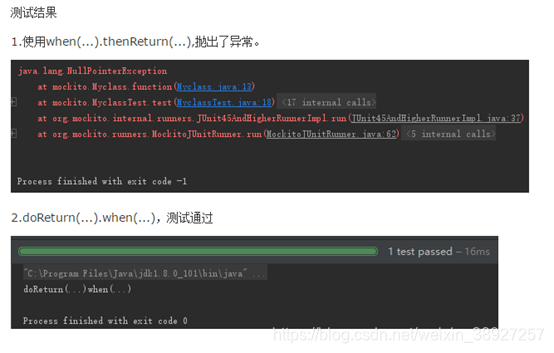创建一个Mock
@Mock: 创建一个Mock.
@InjectMocks: 创建一个实例,其余用@Mock(或@Spy)注解创建的mock将被注入到用该实例中。
注意:必须使用@RunWith(MockitoJUnitRunner.class) 或 Mockito.initMocks(this)进行mocks的初始化和注入。
@RunWith(MockitoJUnitRunner.class)
public class Test {
@InjectMocks
private SomeHandler someHandler;
@Mock
private OneDependency oneDependency; // 此mock将被注入到someHandler
// ...
}
mockito-初始化注解
如果想使用@Mock, @Spy, @InjectMocks等注解时,需要进行初始化后才能使用。 初始化的方法有3种:
1,在Junit的类上面使用@RunWith(MockitoJUnitRunner.class)注解。
但如果你使用的是Spring的话,可能你会使用Spring的测试类(@RunWith(SpringJUnit4ClassRunner.class))
这样的话,你就没有办法使用上面的@RunWith(SpringJUnit4ClassRunner.class)。你还可以使用下面的方法。
2,在测试方法被调用之前,使用MockitoAnnotations.initMocks(this);。例如:
@Before
public void initMocks(){
MockitoAnnotations.initMocks(this);
}
@Before保证了在被测试的方法被调用之前,调用@Before所注解的方法,可以用来把@Test的数据初始化
3,使用MockitoRule。如下:
@Rule
public MockitoRule rule = MockitoJUnit.rule();
这个方法会调用validateMockitoUsage方法。这个方法有一些好处,具体什么好处还不太清楚。
Mock和Spy
项目中,有些函数需要处理某个服务的返回结果,而在对函数单元测试的时候,又不能启动那些服务,这里就可以利用Mockito工具。Mockito中的Mock和Spy都可用于拦截那些尚未实现或不期望被真实调用的对象和方法,并为其设置自定义行为。二者的区别在于:
1、Mock声明的对象,对函数的调用均执行mock(即虚假函数),不执行真正部分。
2、Spy声明的对象,对函数的调用均执行真正部分。
例:
public class Main {
public void fun(String s) {
System.out.println(s + " : fun");
fun1(s);
fun2(s);
}
public void fun1(String s) {
System.out.println(s + " : fun1");
}
private void fun2(String s) {
System.out.println(s + " : fun2");
}
public int getVal(){
return 5;
}
}
Mock使用实例
1、使用doCallRealMethod().when()调用函数真正部分。
2、使用when().thenReturn自定义函数返回值。
import static org.mockito.ArgumentMatchers.anyString;
import static org.mockito.Mockito.doCallRealMethod;
import static org.mockito.Mockito.when;
import org.junit.Before;
import org.junit.Test;
import org.mockito.Mock;
import org.mockito.MockitoAnnotations;
public class MainTest {
@Mock
Fun mockFun ;
@Before
public void init() {
MockitoAnnotations.initMocks(this);
}
public class Fun {
public void fun(String s) {
System.out.println(s + " : fun");
funone(s);
funtow(s);
funthree(s);
}
public void funone(String s) {
System.out.println(s + " : fun1public");
}
protected void funtow(String s){
System.out.println(s + ": fun2protected");
}
private void funthree(String s) {
System.out.println(s + " : fun3Private");
}
public int getVal(){
return 10;
}
}
@Test
public void testFun() {
// 执行mock,而不是真正部分,所以没有打印任何信息
mockFun.fun("mock test One");
// doCallRealMethod声明后,执行真正部分
// 如果是public和protected函数则进行mock,如果是private函数则执行真正部分
// 但是Mock只能对public(fun1)和protected函数进行mock
// 对private函数(fun2)仍执行真正部分
// 所以输出fun和fun3Private
doCallRealMethod().when(mockFun).fun(anyString());
mockFun.fun("mock test Two");
// 执行mock,输出int的默认值0,而不是10
System.out.println("val: " + mockFun.getVal());
// when声明后,既不走真正部分,也不走mock,直接返回thenReturn()中定义的值
// 注意:该值的类型需要和when中函数返回值类型一致
when(mockFun.getVal()).thenReturn(20);
System.out.println("val: " + mockFun.getVal());
}
}
运行结果:
mock test Two : fun
mock test Two : fun3Private
val: 0
val: 20
Process finished with exit code 0
Spy使用实例
@Spy
Fun spyFun;
@Test
public void testspyFun() {
// 执行真正部分
spyFun.fun("mock test One");
// 执行真正部分
System.out.println("val: " + spyFun.getVal());
// 自定义返回值
when(spyFun.getVal()).thenReturn(20);
System.out.println("val: " + spyFun.getVal());
}
运行结果:
mock test One : fun
mock test One : fun1public
mock test One: fun2protected
mock test One : fun3Private
val: 10
val: 20
Process finished with exit code 0
Mockito when(…).thenReturn(…)和doReturn(…).when(…)的区别
在Mockito中打桩(即stub)有两种方法when(…).thenReturn(…)和doReturn(…).when(…)。这两个方法在大部分情况下都是可以相互替换的,但是在使用了Spies对象(@Spy注解),而不是mock对象(@Mock注解)的情况下他们调用的结果是不相同的(目前我只知道这一种情况,可能还有别的情形下是不能相互替换的)。
● when(…) thenReturn(…)会调用真实的方法,如果你不想调用真实的方法而是想要mock的话,就不要使用这个方法。
● doReturn(…) when(…) 不会调用真实方法
public class Myclass {
public String methodToBeTested(){
return function();
}
public String function(){
throw new NullPointerException();
}
}
@RunWith(MockitoJUnitRunner.class)
public class MyclassTest {
@Spy
private Myclass myclass;
@Test
public void test(){
// when(myclass.methodToBeTested()).thenReturn("when(...)thenReturn(...)");
doReturn("doReturn(...)when(...)").when(myclass).methodToBeTested();
String str = myclass.methodToBeTested();
System.out.println(str);
}
}

 Mockito框架详解:Mock与Spy的实战
Mockito框架详解:Mock与Spy的实战








 本文深入探讨Mockito测试框架,讲解如何创建Mock对象,使用@Mock、@Spy和@InjectMocks注解。重点阐述Mock和Spy的区别,以及在实际应用中的示例,包括Mock对象的when().thenReturn()与doReturn().when()的不同行为。
本文深入探讨Mockito测试框架,讲解如何创建Mock对象,使用@Mock、@Spy和@InjectMocks注解。重点阐述Mock和Spy的区别,以及在实际应用中的示例,包括Mock对象的when().thenReturn()与doReturn().when()的不同行为。
















 211
211

 被折叠的 条评论
为什么被折叠?
被折叠的 条评论
为什么被折叠?








